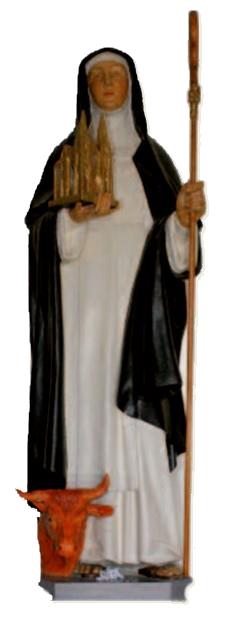 Across the centuries, many saints apart from Nethan have been given particular attention and reverence in this area.
Across the centuries, many saints apart from Nethan have been given particular attention and reverence in this area.
The name of our postal town, Wishaw, most probably derives from a gradual shortening of the name Winstie’s Haugh. Those who remember the pitch and toss school which used to meet near Newmains will know that a Haugh is a forest glade. Winstie is an affectionate shortening of the name Winfrid. (Another name for Boniface - patron Saint of Germany - although St. Winifred, a Welsh Saint was also widely known and revered) Winstie’s name lives on also in Swinstie Road and Swinstie farm in nearby Cleland.
Winfrid’s best known legacy is his dedication of the Fir tree as a Christian symbol, replacing the pagan oak and giving us the basis for the use of Christmas trees.
A Celtic Saint, Aidan of Lindisfarne, was chosen as the patron of the parish Church in the Parish of
Cambusnethan. Another early chapel was named for Michael, Archangel and victor over the powers of darkness. The Abbot Brendan, voyager and possible visitor to the American continent 1000 years before Christopher Columbus, was well known among them but had to await the 20th Century before his name was included among local patrons.
The Irish who came to Newmains brought with them devotion to the saints of their native land. They revered Colmcille who like them had left Ireland to come to Scotland; Patrick too who may have made the journey in the opposite direction and Brigid, Mary of the Gael, a contemporary of Patrick. Brigid, Patrick and Columcille, this trinity of Celtic giants, share a grave, in Downpatrick, Co.Down.
It was to Brigid that the local Catholics turned when they chose a patron saint for the Catholic Community in Newmains.
Our Patroness is often called “Mary of the Gael”. In legend and folklore Celtic tradition is distinguished by the fact that so many of its heroes are women. In the early days of Christianity this tradition continued. Brigid is the most admired of the Celtic Christian heroes after Patrick.
in Kildare a community of women. This was the first religious community in Ireland for women and she is usually called Ireland’s first Abbess. The Irish took her memory wherever they went. She died at about 70 years old and was buried in Kildare but was later re-buried with Patrick & Colmcille at Downpatrick where they remain to this day.
After her death, we are told by Gerald of Wales (13th Century), a fire was kept burning in her honour for several centuries. May this Centenary Year fan the flame of Faith in the parish named in her honour here in Newmains.
“vive ut semper vivas”
Brigid was born in Faughert around 1500 years ago and her birth was marked by signs and marvels. Neighbours told of a “Fire that stretched from Heaven to Earth” that seemed to consume the house in which the child lay but which vanished when they approached. They saw this as a sign of the Holy Spirit.
She was sent into the service of a wealthy cattle owner as a herdswoman. An act of personal self-sacrifice which saved her master’s cattle persuaded him to reunite her with her home. But she was called to a greater family. Her wish was to bring souls to God and soon her life was given over to this purpose. But she did not lose her personally attractive qualities. She was loved and much regarded for her strong and happy personality as well as for her goodness and generosity. Many of the stories told of Brigid are legend rather than history but it is the goodness and generosity that is their recurring theme. She is said several times to have multiplied food to feed the poor and one story even has her changing bath-water into beer to slake the thirst of some priests who had come to visit the monastery she founded.
Brigid recognized the special gifts that the women of Ireland could bring to the work of God. She founded in Kildare a community of women. This was the first religious community in Ireland for women and she is usually called Ireland’s first Abbess. The Irish took her memory wherever they went. She died at about 70 years old and was buried in Kildare but was later re-buried with Patrick & Colmcille at Downpatrick where they remain to this day.
After her death, we are told by Gerald of Wales (13th Century), a fire was kept burning in her honour for several centuries. May this Centenary Year fan the flame of Faith in the parish named in her honour here in Newmains.
“vive ut semper vivas”
